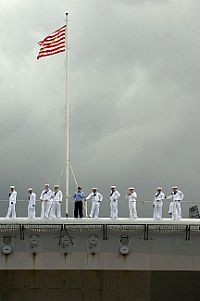Talent acquisition leaders from private-sector companies aren’t the only ones trying to recruit more people with finite resources. The U.S. Navy Recruiting Command has given management and technology consulting firm BearingPoint a contract to improve its recruiting efficiencies, in an effort to meet future hiring quotas for uniformed personnel and officers. With demand for military personnel escalating, especially in specialized areas, the Navy will use balanced scorecards and Lean Six Sigma to create process improvements and fill requisitions more quickly.
“The goal of the first phase of the engagement is to optimize recruiting efficiencies and resources by providing the Navy with full visibility into its recruiting processes,” says Marc Murphy, managing director for the Navy practice at BearingPoint. “The recruiting mission over the last five years has changed so significantly, that it has created an environment where the Navy must optimize their recruiting model to survive.”
BearingPoint will create dashboards and metrics and gather data in the first year of the contract; it will also employ process-based cost modeling techniques to figure out the true cost of recruiting both enlisted and officer candidates. Later phases will focus on improvements yielded by the initial analysis.
Sears PaYS
It’s not surprising that the military is turning to process improvement to drive recruiting effectiveness, according to Philip Dana, manager of military and diversity talent acquisition at Sears, and an author of a blog you’ve probably seen on ERE. Dana, a Navy veteran, says the military has adapted its recruiting strategies largely through necessity, because it has to compete against other employers for an all-volunteer workforce. Like most employers, Sears competes with the military for employees, but it also contributes to the military’s recruiting prowess by guaranteeing job interviews to returning vets through the Army’s PaYS program. Doing so gives Sears a pipeline of future workers.
PaYS, which stands for Partnership for Youth Success, helps soldiers obtain a civilian job after serving in the Army. The program begins upon enlistment, when the soldier designates his or her future job and employer preference. The soldier’s site visits and interview are scheduled six months prior to their separation from the service.
In addition, Sears sources future leaders from the Army by partnering with the PaYS ROTC program. Earlier this week, Sears agreed to expand its contract, which includes sourcing privileges at the 273 ROTC college campuses located around the country. The program allows partners to post positions and maintain relationships with cadets during their last two years in college.
“With 40% of corporate leaders expected to retire in the next few years, I think there will be increasing interest from companies in this program,” says Dana. “Officers are educated and they have the leadership skills and training private businesses are seeking.”
Just this week, President Bush signed a revised version of the GI Bill which will fully cover the cost of a four-year college degree for returning veterans for the first time since the Vietnam War. Given the expanded benefits, it makes sense for corporate recruiters to join the Army’s recruiting program rather than fight it, because the Army has enveloped its recruiting process in a complete career planning strategy that may be hard for private businesses to match.